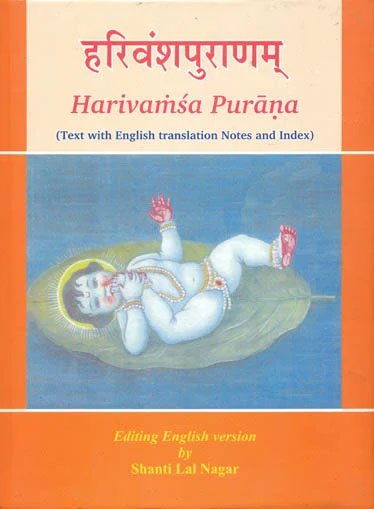Harivamsha Purana
by Manmatha Nath Dutt | 1897 | 293,872 words | ISBN-10: 8178542188 | ISBN-13: 9788178542188
This page is entitled “the creation of rivers” and represents Chapter 17 of the third book (Bhavishya Parva’) of the Harivamsa (English translation in Prose). The Harivamsha Purana narrates the lineage and life-story of Krishna (Hari). Although not officially mentioned in the list of Puranas, this book includes topics such as geology, creation theory, time (manvantaras), ancient historical legends and accounts of royal dynasties.
Chapter 17 - The Creation of Rivers
1. Vaishampayana said:—The mount Mainaka was fixed in that hole which was created on the face of the earth by the increasing sun.
2. It was called Parvata because it filled up the ocean of desire and Achala because it was fixed: by nature, it was however called Meru.
3. On the spacious summit of the mount Sumeru lives that highly prosperous Purusha, begotten by effulgence, and manifest with head, feet, etc. He was created by the Great Soul through Nature.
4. The Brahma energy, that is laid inside the head, assumed the lustrous burning form of Purusha.
5-6. From his mouth emanated as if burning in his effulgence Brahma with four mouths and with four foremost of the twice-born, the foremost of those conversant with the knowledge of Brahman. From him the great elements again came into being.
7. The earth was upraised from water by Brahma who was stationed in his room (on Meru), therefore though invisible he came within the vision of men.
8-10. Brahma’s region, the summit of Meru, is situated at the junction of heaven and earth. It is a hundred or a thousand Yojanas in height and its extent is four times as much. No man, with his celestial wisdom, can within many thousand years, measure its height, for the dimension of the Meru is only imaginary and cannot be gauged like the extent of a desert or the depth of a lake. Like its height and extent its circumference is also limitless. O king, the extent of the mount Sumeru bounded with four side hills is a hundred Yojanas.
11. And some anchorites, of accomplished asceticism, conversant with the knowledge of Brahman, attribute innumerable other virtues to this mount.
12. With Maruts, gods, Rudras, Vasus, Adityas and Vishvadevas he protects the Regents of the earth.
13-14. O king, with the Divine Vishnu he protects the earth emanating from the sun (fire) and Varuna (water) in his Brahmana body obtained from Brahma, Vishnu’s energy is equal everywhere.
15. With various observances the truthful Brahmanas, proficient in the study of the Vedas, have sung the Brahman.
16. All the three worlds exist in Brahman and Brahman pervades all either as being manifest or unmanifest.
17-20. The Brahmanas, who have mastered the Vedas consider those actions as conducive to our well-being—the daily obligatory rites sanctioned by the Vedas, breathed out by Isvara and practised by those Brahmanas who are not deceiptful even in words, not to speak of works, through the purification of their mind. Although these rites yeild fruits of good works still they constitute but an iota of Braman. So the Srutis hold. The truthful Brahmanas declare that this universe is but a minutest part of Brahman who is the soul of all. On account of the diversity of their mental faculties the Brahmanas worship one Brahman in sacrifices under various names such as Brahma, Indra, Mitra, Varuna etc. The Vipras name in various way the one great Brahman. The form of the universe is gross and that of the mind is subtle. And thinking that these two forms belong to understanding only the Lord first created the union of male and female.
21. Having made arrangements for diverse enjoyments the Divine Lord Brahma enjoys them along with the goddess and his followers.
22. Brahma is the foremost of Brahmavadins, who, although they are desirous of following humble pursuits, always wend the way leading to emancipation.
23. (Uma is spiritual science and Paramesvara is the eternal Jnana understanding) his body is the stream of water flowing from heaven. Soma is born from this stream;and by it Maheshwara is the lord of goblins.
24. It is called nadi river because having installed naturally Mahesvara as the king of ghosts it made a great noise.
25. Supporting herself on the region of Brahma and passing through the mountains that stood in her way she descended on earth by seven ways: and for this she is called Ganga.
26. O king, in the form of Godavari Ganga divided herself into seven before she joined the ocean and coursed on various sacred shrines having divided herself into a thousand parts in the shape of Janhavi.
27. First gross elements are produced from the great elements and then the actions of the intelligent begin.
28-29. From his four lotus mouths the Veda was produced which since then became the fountain of spiritual instructions to mankind. The sacred sacrifice was an emanation of his Jnana, understanding, and the four priests were its four legs—and the grand-father Brahma was the lord.
30. The four legs of Dharma by which the world is upheld are (the four Asramas), first Brahmacarya—the condition of a student, and secondly the most sacred condition of a house-holder.
31. The third stage is that of a religious recluse in a forest, and the fourth is that of union with the great Brahman. These four stages of a religious life are regarded as leading to the attainment of heaven.
32. The mental faculties of a man develop through the practice of Yoga and the true understanding of the Vedanta. And the eternal Vedas exist for the practice of Brahmacarya.
33. The Pitris are gratified with observing the conduct of the house-holders and the Rishis, stationed on the summit of the mount Sumeru, are gratified with Yoga.
